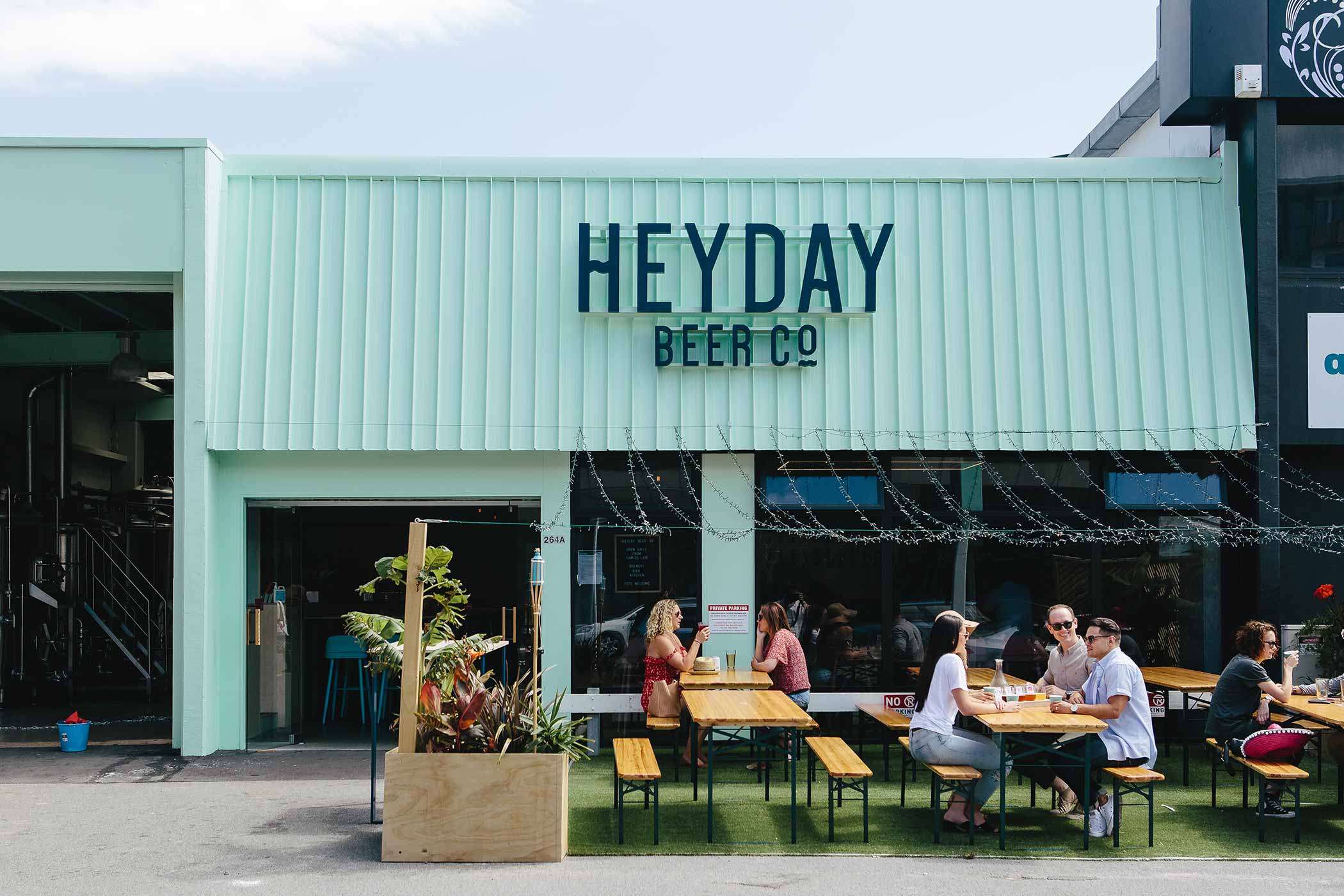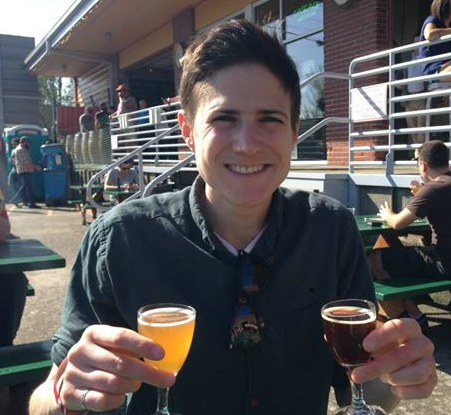Shop
Step Back to a Simpler Time With Wellington’s Heyday Beer Co.
Back in the day...
Top Stories:
As I walk down the bustling Cuba Street in Wellington, New Zealand, a seafoam green facade emerges, a pop of brilliance amidst the din.
Behind a simple wooden slatted fence, an outside beer garden buzzes, packed picnic tables full of flights and conversation. Groups of people stand around on the turf, soaking up the intermittent rays of sun peaking through the clouds.
Walking under the rolltop doors, a similar seafoam-tiled bar immediately splashes out at me, drawing me closer. To my right, the brewery’s gleaming steel tanks stand in the open for all to see, a conscious decision from Heyday Beer Co.. Co-Founder, Director, and Designer Hannah Blackwood “to get the best out of the brewers, but also to let the customer feel involved in the process.”
At Heyday Beer Co., at the bottom of New Zealand’s North Island, the motto is simple: “Be Kind, Stay Safe, Drink Beer.”
It’s a slogan that harkens back to a different time. One where neighbors traded sugar and hosted summer barbecues. Walking inside feels like stepping into your childhood best friend’s basement rather than a brewery.
And just like in a favorite place from your memories, at Heyday, you want to keep coming back again and again, letting yourself in through the back door.
Or, in this case, that iconic mint green roll-up at the front.
This is one of Wellington’s best breweries, and they’re inviting you to come inside, have a beer, and remember a simpler time.
Harkening Back to Your Heyday
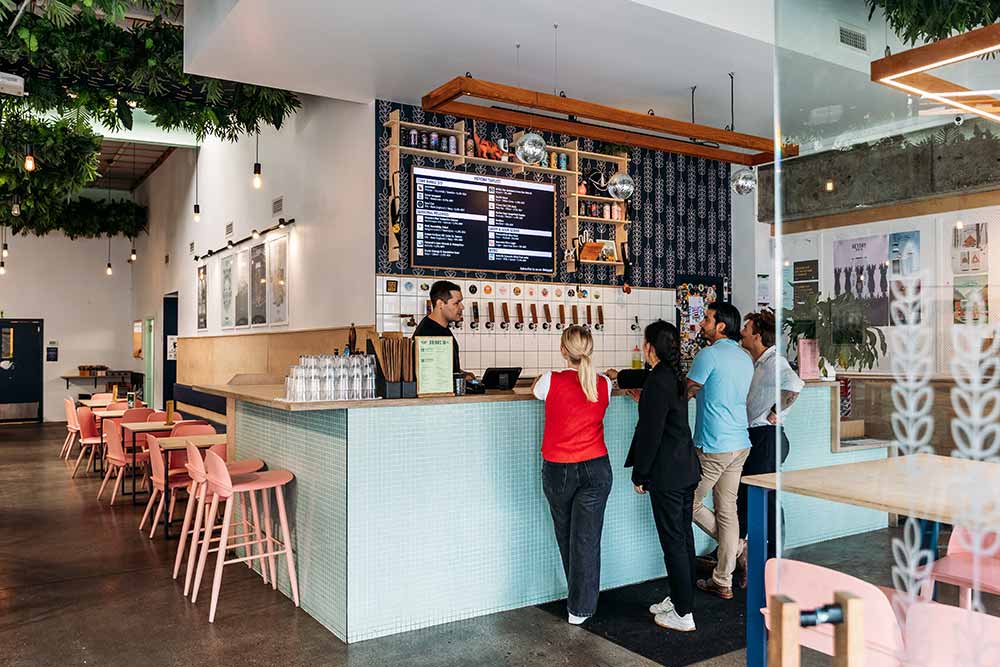
Photography courtesy of Anne Briggs | WellingtonNZ
This is not to say the brewery is old-fashioned, far from it. But it’s hard to stand in front of the aquamarine bar without seeing flashes of Julia Child’s kitchen, all celadon green tile and colored cabinets. There is an intentional simplicity here that harkens back to, well, a heyday.
“When things are in their heyday, they’re nostalgic and at the height of their popularity,” explains Blackwood as I sit down with her on a sunny, slightly windy Wellington afternoon, a tasting flight in front of me. ”I wanted the place to be a little bit retro, a little bit funky.”
The decorations aren’t the only nod to the past here.
A designer by trade with an honors degree from Massey, Blackwood dreamed up the idea to start a brewery with one of her other business partners during a three-month trip across the States in 2015.

Photography courtesy of Lewis Culshaw Photography (on the top) and Heyday Beer Co. (on the bottom)
Starting in Los Angeles, where she enjoyed a Pliny the Elder for the first time, Blackwood and her friend next headed to Portland, OR, because she heard it was “the place to go.” From there, Blackwood took the train to Vancouver before flying across to New York City and eventually driving down to Florida.
Each place she stopped, “Instead of where should we get an accommodation or what should we do, we were like, where is the ‘it’ brewery,” she says.
When speaking to people at the breweries they visited, Blackwood says people often took them out for dinner or even gave them accommodations.
“It was a really nice experience,” recounts Blackwood, who describes herself as more of an introvert. “It actually brought me out of my shell.”
While at M.I.A. Brewing Co. in Miami, Blackwood had an epiphany, mentioning to her partner, “Hey, you’re a builder, I’m a designer, and we homebrew. I reckon we can start a brewery.”
Returning to Wellington, Blackwood started looking for a space. Originally planning to move into a venue down the road from the current location, Blackwood says a quirk of fate caused those plans to crumble. A few minutes after midnight on Monday, November 14, 2016, the Kaikōura earthquake shook through Wellington. Set to move in that same day, Blackwood says instead, she woke up to a building condemned.
It would take six more months of viewing little dingy bars as potential spaces before she came across an old car garage with a rollup door. “When we saw the place,” says Blackwood, “it was a bit of a no-brainer.”
Where the brewery’s located on Cuba Street has somewhat of a checkered past.
A couple blocks up from Heyday is a set of traffic lights. Years ago, Blackwood, who attended Massey University less than ten minutes away, says she would have described the area as the “seedy end of town” with strip clubs. “My mom used to say don’t go past these lights,” says Blackwood. But today, the area is full of funky little shops and cafes. “This is a great end of town,” says Blackwood, ticking off an Italian restaurant she’s been dying to go back to, an Argentinian one, and a pizza spot in what used to be a dingy karaoke bar.
Heyday is one of those businesses recapturing the neighborhood.
Inviting All Inside
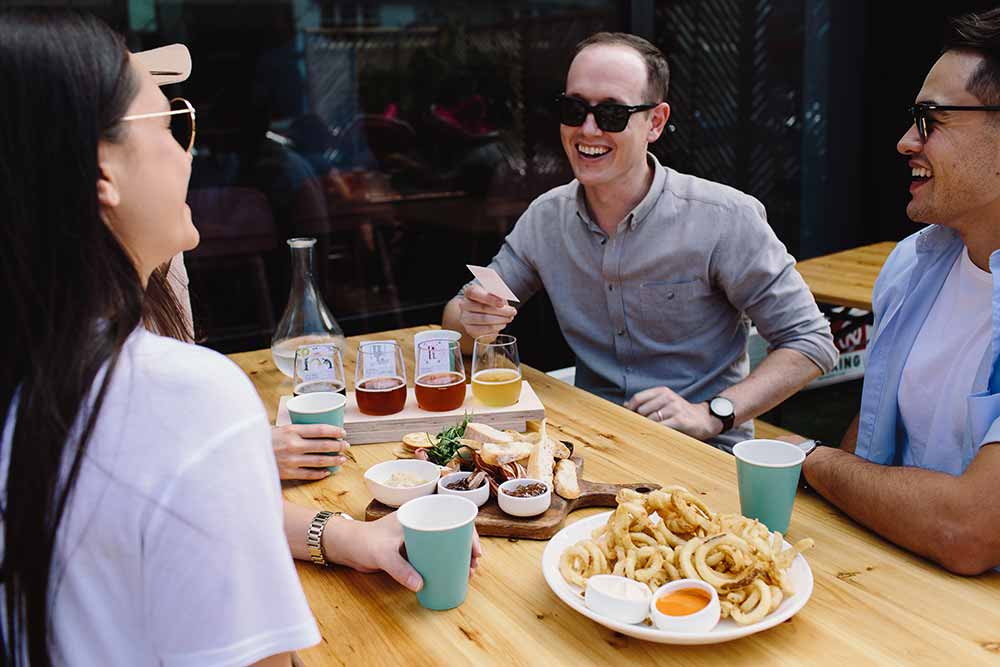
Photography courtesy of Pivot Photography and WellingtonNZ
Blackwood starts to talk a little faster as she ticks off breweries she admires: TALEA Beer Co., Bellwoods, Temescal, Inkhorn, and Fat Orange Cat, to name a few.
“I wanted bright (but not fluoro), airy, and cheerful,” explains Blackwood, who hoped her focus would make the place more inclusive of everybody, “not just the beer connoisseur who sits at a dark mahogany bar.”
She adds, “And if there is a beer connoisseur, he doesn’t care that he’s sitting on a pink seat!”
It’s these pops of color and influence that have set Heyday apart, literally.
If you’ve ever seen a lipstick-pink van driving around Wellington, that’s probably Heyday Head of Sales Tyler Cornes in the brewery van.
“It’s pink, so people know it’s you,” says Cornes. “There’s no hiding from the brand.”
In fact, according to Blackwood, someone once left a Google review on Heyday’s page, “Never tried the beer, but whoever’s driving the pink van needs to speed up; he’s driving like my grandmother.”
Heyday isn’t afraid to embrace who they are: a little vintage, a little thrifty, a lot of soul.
Those iconic mint green tiles? They came at a bargain on Trade Me, a New Zealand auction site, inspiring the bold color that pops on the exterior.
Instead of a huge space full of knick-knacks, Blackwoods went for a more clean aesthetic. “That has evolved over time to make the place seem more lived in,” wrote Blackwood in a follow-up email to Hop Culture, “and show the personality of the staff and beers.”
Personality in Every Pore
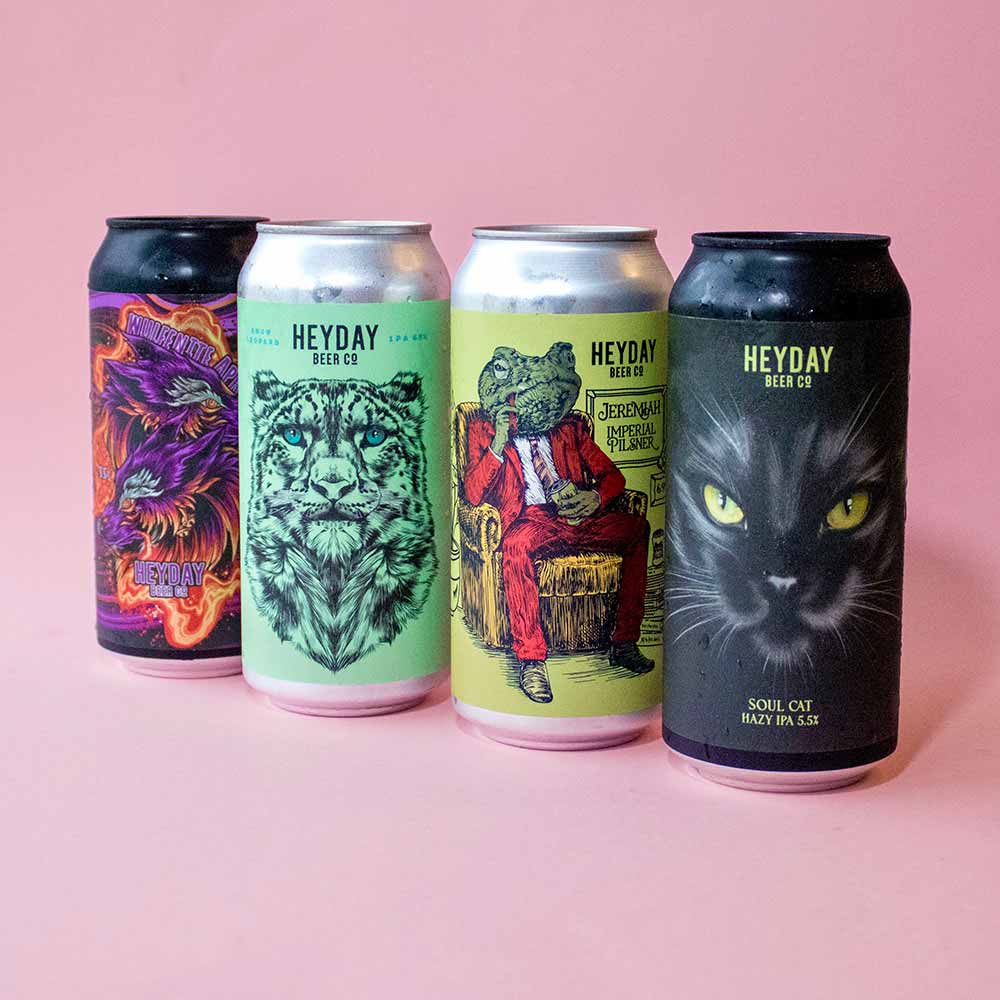
Photography courtesy of Lewis Culshaw Photography
Personality oozes out of Heyday’s beers. I think this as I stare at a matte black can, a pair of golden eyes flecked with jungle green staring back at me. The look isn’t menacing, but it does pierce my soul. Inspired by Blackwood’s seventeen-year-old cat Queenie (full name: Queenie Fi Blackwood), Soul Cat is currently one of Heyday’s core beers. And a pretty good reflection of Heyday’s brewing philosophy.
The 5.5% ABV hazy IPA “moves away from the 7% ABV, chewy, thick, almost pulpy hazies that New Zealand did for a while,” explains Blackwood, who creates all of the labels. “It’s hazy, just not a meal in a beer.”
A grist of a light American ale Gladfield malt paired with a little oats and wheat ensures the beer is hazy but not pond-scum turbid. “It’s not complicated,” says Heyday Head Brewer Ashley Switzer, a native Kiwi who started brewing in New South Wales, Australia, before moving back home and connecting with Heyday. It just gets the job done and gives the beer a bit more body.
A dry-hop of Simcoe, Mosaic, and Sultana Cryo hops with some Idaho 7 in the whirlpool, Soul Cat has “the fruitiness you expect of those hops,” explains Cornes, “but you won’t find it sickly sweet. There’s a little bit of dryness…to entice you to have a couple of them.”
Switzer describes that beer as presenting with very pineapple-y, dank notes.
When we say these beers have personality, here is what we mean. Soul Cat is the surviving beer from a series of hazies that paired cats with Marvel’s infinity stones: Mind Cat, Power Cat, Reality Cat, Space Cat, and Time Cat. Who even thinks of something like that?
Heyday does.
To be fair, felines often inspire Blackwood, who has fully embraced she’s “the cat lady of the beer industry.”
The best-selling Soul Cat is the only beer to survive that hazy run. (But don’t worry, no one was sacrificed while making this one.)
“The important thing is that people like to drink it,” says Switzer, “that’s all that really matters.”
Actually, the decision is part of Heyday’s effort to hone in on its portfolio.
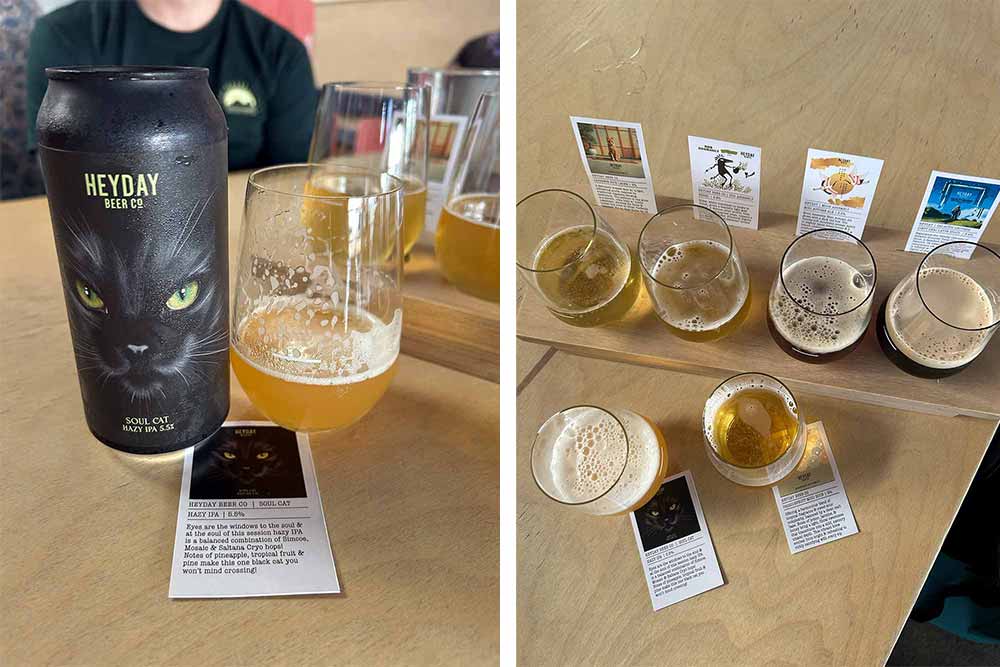
Photography courtesy of Hop Culture
Originally, the brewery made new beers all the time, brewing around fifty in its first year. “We wanted people to come in and see a whole new tap list every time,” says Blackwood. But that intensity wasn’t sustainable.
Two years ago, the brewery started a core range, which now includes Soul Cat, Snow Leopard IPA (which Cornes tattooed on his thigh a few weeks before our visit), Jeremiah New Zealand imperial pilsner, and potentially a new pale ale-like beer called Coyote Gold.
But that doesn’t mean they’re not still having fun.
“From my perspective, we just try to brew really good quality beer and really interesting beer,” says Switzer. “We try to make every batch just one percent better.”

Photography courtesy of Anna Briggs | WellingtonNZ
Last year, Heyday started a new “Lager & Sour Series,” releasing a new beer in each style every month.
The vision is to capture drinkers who want something more traditional (lagers) and those willing to try something funky and fruity (sours).
Those like the Passionfruit Miso Sour.
Passionfruit Miso
As I sat down with Blackwood and Cornes in the taproom, they asked if there was any style of beer I didn’t like.
After a moment’s pause, I replied, “I’m not a huge fan of sours.”
A look passed between them. Well, today, you’re going to taste some sours!
I laughed, unaware that I would try one of my favorite funky sips of the entire trip by the end of the night.
To make me feel a little better, Blackwood shared, “I never thought I would drink sours, but now I drink sours by choice.”
Heyday’s latest release in the sour side of its new series, Passionfruit Miso Sour, came from the mind of Heyday Lead Brewer Shan McGregor.
Inspired by cooking with miso paste, McGregor thought the sweetness and acidity of sour beer would nicely complement the savory characteristics of miso.
“Passionfruit was a no-brainer,” he says. “It’s so vibrant and dramatic.”
Switzer praises the puree especially. “If you cook fruit, it changes the flavor of it completely,” he explains, noting that the high-pressure pasteurized version they use “gives us fruit that tastes as if it’s fresh, and it’s just phenomenal.”
McGregor adds white miso paste five minutes before the end of the boil to avoid denaturing any essential proteins and flavors. He says the Japanese fermented soybean presents in the beer as “not salty, not umami, but savory.”
To me, everything was just perfectly balanced. When you hear something like passionfruit and miso in a beer, it gives you pause. But nothing went out of whack. A zip from the passionfruit didn’t cause me to pucker because the savoriness of the white miso paste stepped in to tango together. It was a truly delicious beer.
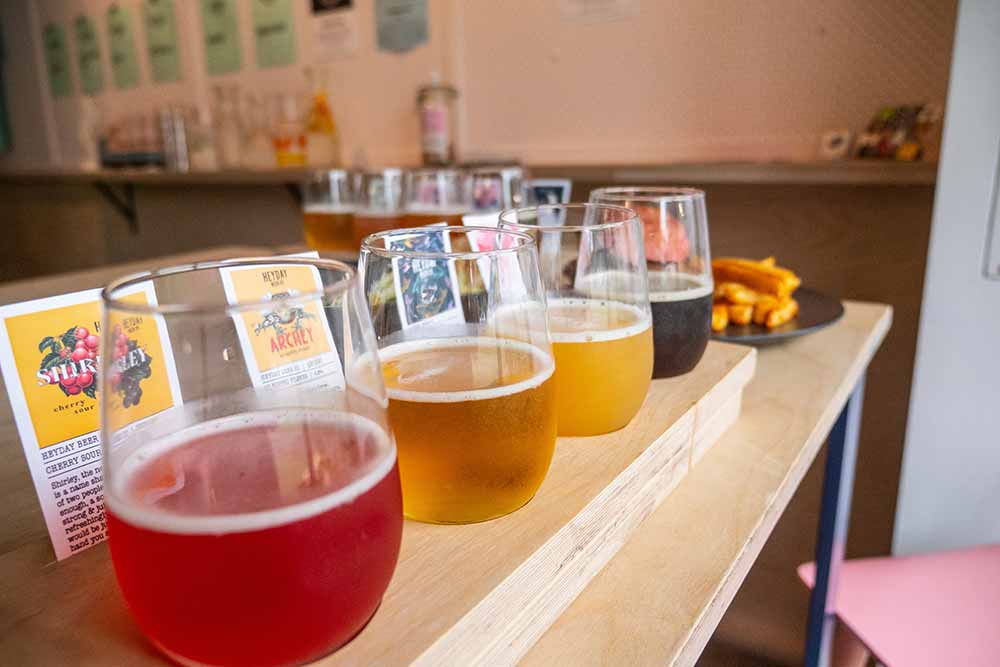
Photography courtesy of Johnny Hendrikus | WellingtonNZ
Jeremiah Imperial Pilsner
On the lager side of things, Jeremiah imperial pilsner drinks like a cross between a New Zealand pilsner and a New Zealand IPA. A favorite of Cornes, Switzer, and Blackwood, Jeremiah has the hop character and ABV of an IPA but the crispiness and drinkability of a pilsner.
“It ticks a lot of the boxes,” says Cornes, noting that an imperial pilsner is “something you just don’t see that often.”
A healthy dose of Riwaka in the dry hop gives the beer a “danky, kerosene-y, almost passionfruit-type vibe,” according to Switzer, noting some Freestyle Motueka hops add a supporting citrus and tropical fruit backbone. “The idea is just to be super crisp, but also really flavourful and just have that New Zealand hop character.”
Including this beer style in Heyday’s core lineup still “raises eyebrows,” says Cornes. “But when people come in and see we have a pilsner in the core range, they remember that beer and it’s a memorable experience for them.”
Much like the story behind this beer. Blackwood says a late-night karaoke session during a work trip in Queenstown inspired the name. “I’d never done karaoke before, but it was five in the morning in our Airbnb, and I was on the floor singing Jeremiah Was a Bullfrog,” laughs Blackwood.
Japanese Rice Lager
The beer I kept going back to again and again as I sat with Blackwood and Cornes that night was the Japanese Rice Lager. Something about its dry crispness paired perfectly with our dinner, and even after trying a taste of ten different beers, it seemed to pleasantly smooth out everything.
And I know I wasn’t the only one.
“I took a case of low-fills home at the end of our last canning run,” says Switzer. “They lasted only a few days!”
A summer beer from Heyday’s lager and sour series, the Japanese Rice Lager was brewed to be crushable.
Switzer describes it as “clean with a little bit of sweetness coming through mid-palate from the rice. It finishes nice and crisp and is just a beer that you want to keep drinking.”
I can attest that is true.
A New Belgian Series
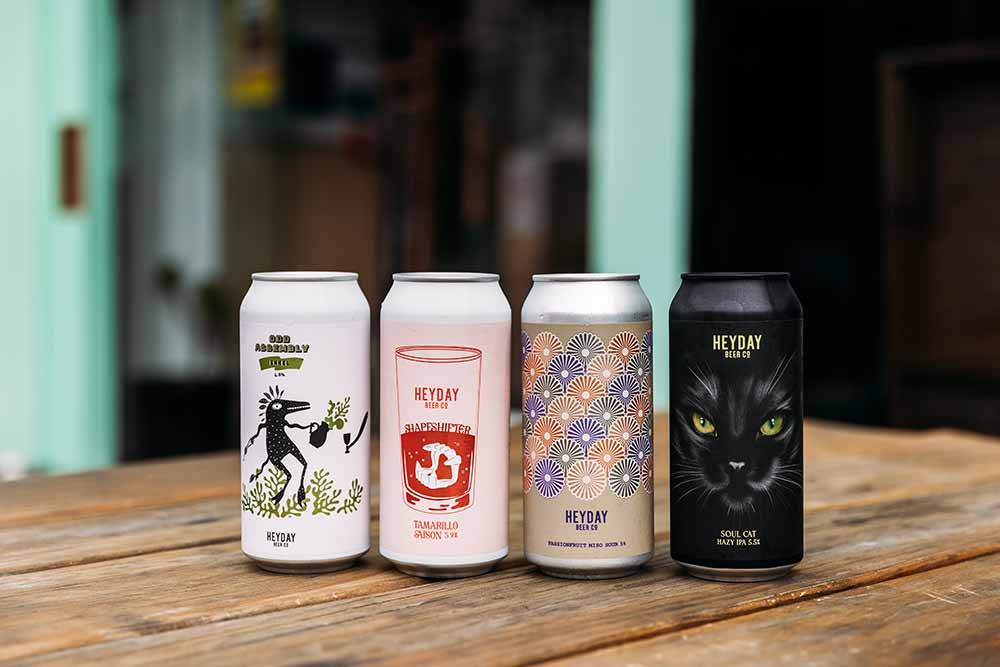
Photography courtesy of Anna Briggs | WellingtonNZ
Looking to the future, Heyday has plans this year for an entire Belgian-focused series, brewing four beers, including a single, dubbel, tripel, and quad.
Switzer and McGregor are especially proud of the single (or enkel in Dutch) I tried during my visit, called Odd Assembly: Enkel.
“The Enkel is unbelievably great right now,” shares McGregor, who believes yeast-driven beers will be the next wave in Wellington.
Switzer agrees these Belgian yeast-focused beers have been “heaps of fun” yet challenging to brew. “We’re not looking at hops; we’re not looking at complex malt bills,” he says. “We’re looking at really good brewing practice and really solid fermentation.”
Utilizing a Belgian monastery yeast (“allegedly Chimay,” says Switzer) from White Labs called WLP500 Monastery Ale Yeast, Heyday has repitched the yeast from the single to the dubbel to the tripel to the quad. “I’m super stoked with its performance,” says Switzer. “Even harvesting it from an 8% ABV beer and chucking it into a 10% ABV beer, it just chipped away and got the job done.”
Cold fermenting, Switzer casts the yeast in at 16° C (60.8° F) before letting each of these beers free rise to 19° C (66.2° F) and “letting it go towards the end,” explains Switzer. “But none got that much over probably 22° C (71.6° F).
The cold start keeps the distinctive Belgian yeast from presenting too many esters, keeping that flavor profile in check while allowing them to develop a ton of flavor in the beer.
For instance, the Enkel “throws a lot of those beautiful banana esters with real light touches of bubblegum and subtle notes of spice, clove especially,” says McGregor.
At the time of publication, Heyday still had the dubbel in package can-conditioning with the plan to release in a couple of weeks, had recently packaged the tripel, and had the quad in tanks with plans to condition and release in mid-August.
“This morning, it was throwing off like cacao, marshmallow, and Turkish delight,” McGregor says excitedly.
Overall, the entire Heyday team has been excited about this Belgian series.
“It’s probably new to a lot of Kiwi beer drinkers,” says Cornes. “We’re going to be a little bit ahead of the curve.”
It’s all a part of Heyday’s approach to stand out.
“We’re quite proud of our diversity,” says Switzer. “We give ourselves a good challenge and try not to brew the norm but to excite, educate, and expand people’s ideas of beer.”
Standing Out
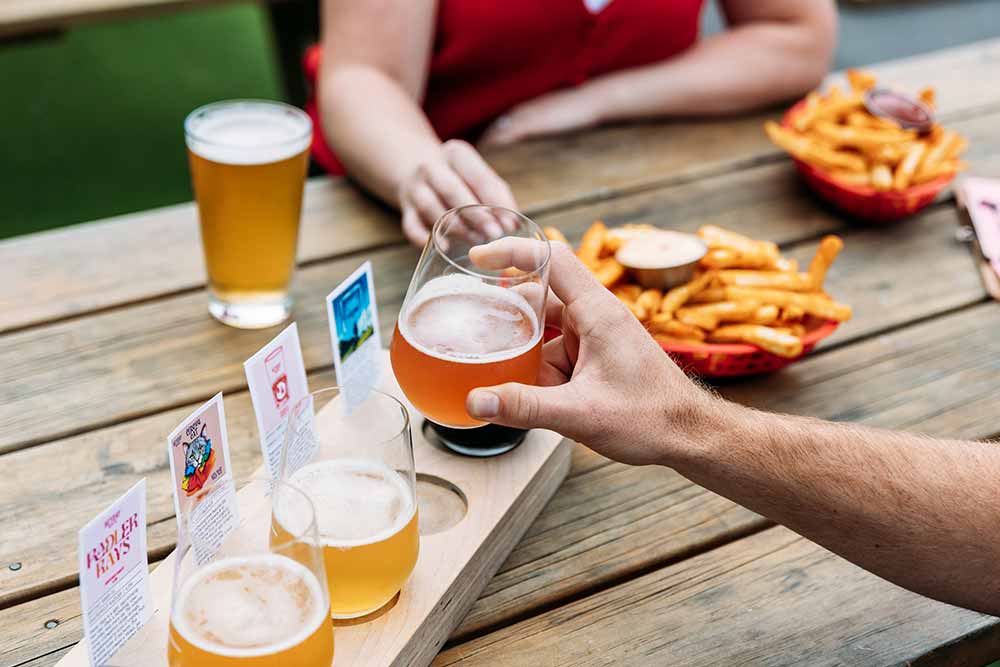
Photography courtesy of Anna Briggs | WellingtonNZ
With over three hundred beers under its belt in just eight years, differentiating Heyday has been imperative to Blackwood.
That is why Soul Cat has an all-black finish. “It stands out,” says Cornes.
Blackwood, who admits that her style is eclectic and often changes, finds inspiration everywhere.
A deep Reddit thread for research on a tamarillo saison mentioned the fruit shapeshifts because it can be used in everything from savory chutneys to sweet desserts. The beer became Shapeshifter Tamarillo Saison. “I picked a vampire as the shapeshifter of choice, but I wanted to avoid monster grungy details,” explains Blackwood.
Blackwood is a fiend for researching rabbit holes, often looking up more on the adjunct used, region where the beer originated, mythology, national animal, significant landmarks or events, or even famous people.
For instance, an espresso martini stout got the name Catwalk because Blackwood found a tale explaining the origin of the cocktail. Allegedly, a London bartender, Dick Bradsell, concocted the drink in the late ‘80s after supermodel Kate Moss famously asked for a drink that would “wake me up and f**k me.”
Lyrics, conversations, idioms, and weird animals all sneak into Blackwood’s brain for ideas. A random note in her Notes app says, “Cowboys are my weakness.”
“I can only imagine that was something I heard and a potential WCIPA name!” she says.
Blackwood pauses before adding more to the list of references: mythical creatures, ‘90s songs, gemstones, surf breaks, etc.
We think you get the idea.
We Go Until Close
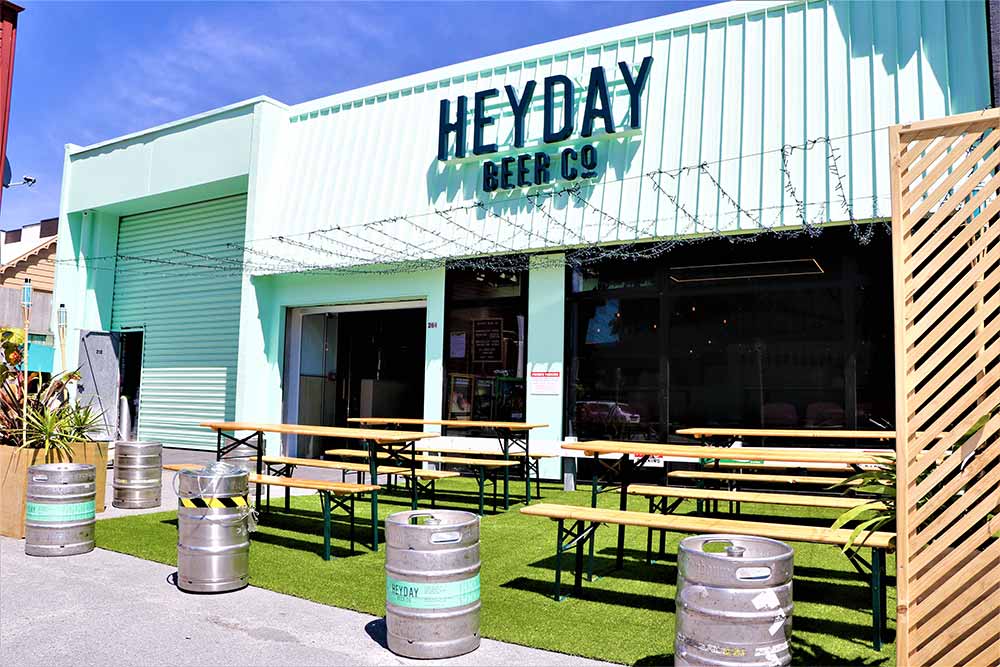
Photography courtesy of Heyday Beer Co.
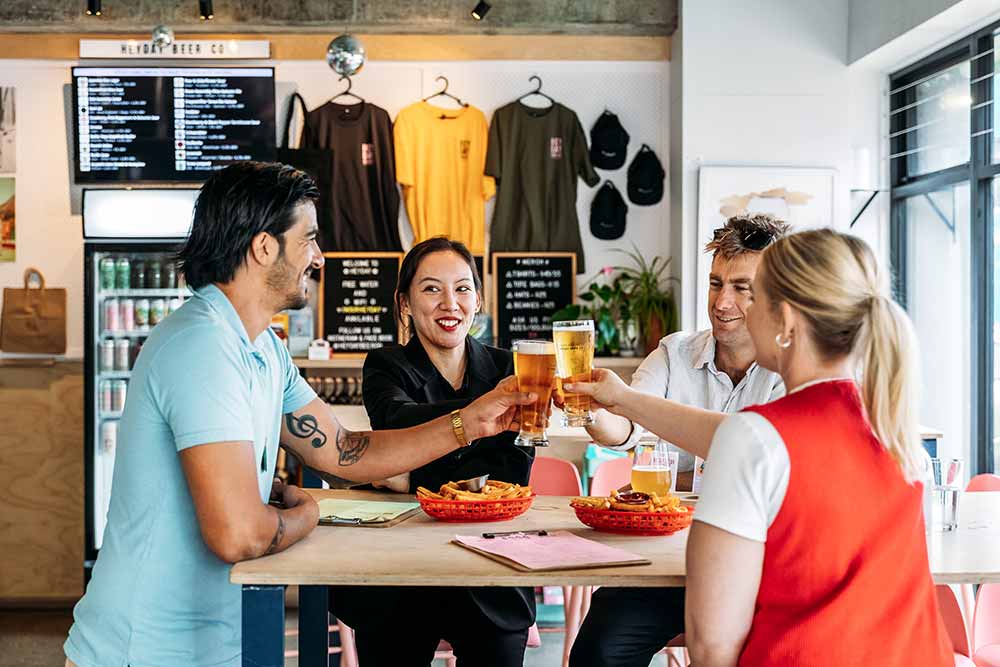
Photography courtesy of Anna Briggs | WellingtonNZ
By the time we look up, night has fallen, and a few hours have flown by. The bar team is cleaning up, and I realize with a start that the buzz has died down and almost everyone has left.
I’m worried we’ve overstayed our welcome.
“What time do you close,” I hurriedly ask Blackwood. She responds that they like the sunshine at Heyday, so while it isn’t a late-night venue, it is a great starter place for the night. One where people come to get their first drinks before going to dinner or other bars. “We go until close in New Zealand,” says Cornes.
That seems about right to me. Because Heyday is the house you know intimately enough to leave your bike lying in the driveway, knocking on your friend’s screen door to see if they’re home and can play on a sunny day.
Here, at a little brewery at the bottom of New Zealand’s North Island, you come as you are, come when you want, and enjoy the Heyday today.

